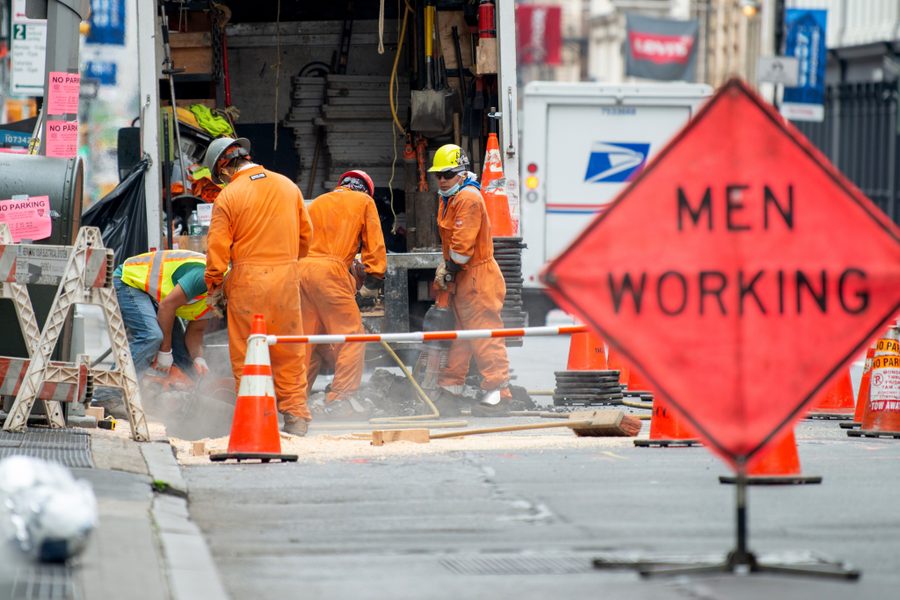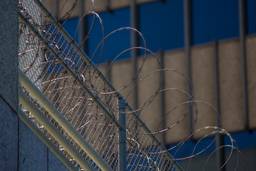How the Construction Industry Preys on Workers Newly Released From Prison
They’re required to work as a condition of release from prison. Then the construction industry targets them for exploitation.
Katie Jane Fernelius

Bernard Callegari, a member of the Construction and Building Laborers’ Local 79 union in New York City, argues that every laborer in his craft jurisdiction deserves to work safely, with dignity and a fair wage. This is why he knew the union needed to take action when its members began to notice that a particular kind of worker was being taken advantage of in the local construction industry.
“We noticed that there was a huge upswing in the workforce that was being used by these body shops, that they were focusing on and targeting the formerly incarcerated as a workforce to be exploited,” said Callegari. This concerned him not just as a union worker, whose local is part of the bigger Laborers’ International Union of North America (LIUNA), but also as someone who himself had once been incarcerated.
In New York City, “body shops” are non-union labor brokers in the construction industry that, Local 79 argues, target recently incarcerated people. While these people are no longer in prison, they often remain under community supervision, meaning that they have to regularly check in with a correctional officer to make sure that they are meeting all the conditions of their release, like holding down a job.
In some cases, workers were connected with these body shops through reentry organizations, which aim to help recently incarcerated people transition back into life outside prison, where employment opportunities can be difficult to find if you have a record. However, once these workers found themselves in those jobs, they frequently experienced low wages and even unsafe work conditions.
This story is, sadly, not uncommon in an industry where nonunion shops are outpacing union ones when it comes to permits for private renovation and reconstruction work, arguably driving down wages. But for those who have been recently incarcerated, the risks compound: If they leave the job in search of better opportunities, or stand up against bad working conditions and, as a result, get fired, they might risk incarceration. This is because work requirements are an incredibly common part of probation and parole sentencing, and if someone is found to be in violation, they could be sent back into prison. In 2019, 40% of prison admissions in New York were for technical parole violations, like failure to maintain employment, according to one report. Nationwide, one study found that on any given day, 9,000 people are in prison for failure to maintain employment on parole or probation, and two-thirds of those imprisoned for parole or probation violations related to work or debt are African American or Latino.
“Most people think about the relationship between the criminal legal system and labor in terms of exclusion, or barriers to employment, such as discrimination against people with a criminal record,” says Noah Zatz, a professor of law at UCLA. “But there’s also a kind of flip-side phenomenon, which is not one in which people are being locked out of work, but when people are being forced into work — and, in particular, forced into work on vulnerable or subordinating terms.”
As of 2018, an estimated 4.5 million people are under correctional supervision through probation and parole, according to the Prison Policy Initiative, almost double the number of people incarcerated in jails and prisons in the United States.
“It is generally understood that almost everybody is subjected to some kind of expectation that they seek and maintain employment,” Zatz said. “It’s a very standard and prominent condition of parole and probation.”
According to Zatz, we can see these work requirements across the board in the criminal legal system — not just in probation and parole. Child support cases frequently invoke the need for fathers to work and pay support, or else be imprisoned. Work requirements also come up in proposed alternatives to incarceration, like community service, which often mandate underpaid or unpaid work outside of prisons.
“There’s a sense in which mass incarceration gets leveraged as a way to lower expectations for what people can and should be fighting for,” Zatz says. “Obviously, there’s a tremendously compelling reason to be resisting incarceration and to be looking for alternatives to it. But, on the other hand, if the fact that something’s not incarceration is enough to validate it, that creates the space for essentially having the threat of incarceration serve as a way to legitimize other forms of abuse and exploitation.”
That exploitation is threaded into the “body shops” model, according to Callegari, who has himself dealt with work requirements as a condition of his release. In New York City, nearly one in four recently incarcerated people works in construction, and across the country, construction is among the most popular sectors for people with a reentry background to work in. Local 79 argues that body shops specifically seek out recently incarcerated people to employ.
“People are prepared to come out and work for low wages, because they’ve been working for low wages for the years that they were in prison,” he said. “Fifteen dollars an hour seems like a lot when you’re used to making $15 a week. But the body shops are the ones that are profiting, and they know that the people they are sending to the job can’t really complain because they need a job or they’re going back to prison.”
In 2020, the Mason Tenders’ District Council, along with Local 79, decided to launch the Laborers’ Fight Back campaign, which promoted “real reentry” for formerly incarcerated workers. As part of that campaign, they drafted and advocated for the Body Shop Bill, or Intro. 2318, which would require greater transparency from labor providers within the construction industry; mandate that employers inform workers of their rights, including their minimum wage and potential overtime pay; and require that employers provide information to the city about the number of works they employ and how much those workers are paid. It also would provide more transparency about whether these employers are following labor law, which would protect any worker from wrongful termination — a safeguard that is particularly important for recently-incarcerated workers who might fear speaking out otherwise.
“The campaign helped to publicize what was actually happening, by way of worker testimony at City Hall public hearings and rallies in the streets,” said Callegari, who is the field director for the campaign.
In November of last year, the city council passed the bill. It is now slated to go into effect in June 2022.
“We don’t have to choose between labor subordination and exploitation on the one hand, and mass incarceration on the other,” Zatz says. “We should be aiming higher.”
He notes that recent organizing has resulted in “ban the box” victories across the country, reductions of fines and fees for those involved in the court system, and even decarceration efforts — all in an effort to fight not just mass incarceration, but also the economic inequality it inflicts.
Zatz hopes to see similar organizing against work requirements.
“The project is to get people to think about how these systems interact,” he said. “The labor movement has an interest in abolition. The labor movement has an interest in working on criminalization and the criminal legal system. This isn’t just a kind of question of broad politics, but of very concrete material interactions.”
For Callegari, the first step is workers acting in solidarity with each other.
“As someone with reentry experience and background, I know firsthand what it’s like to feel like I’m not worthy to receive the same opportunities as other people,” Callegari said. “Being a member of Local 79, I felt equal to all of my brothers and sisters on day one, because we all receive the same pay and the same treatment. And that is the solution to this disparity between those that are justice-affected, and those that are not.”
Katie Jane Fernelius is a journalist and radio producer based in New Orleans.







